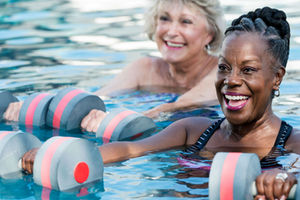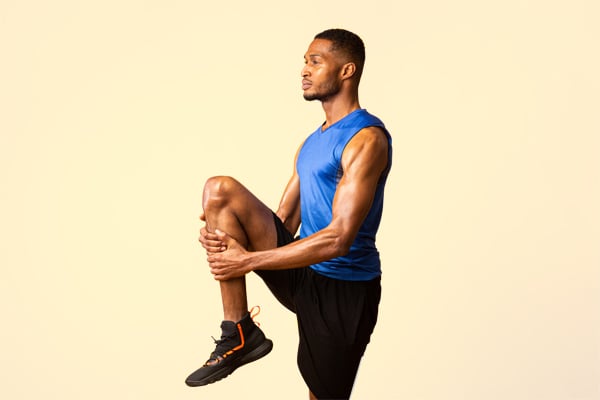
Exercise can be tricky, especially if you live with arthritis or knee injury. Although aqua-based exercises take pressure off your joints, they offer enough resistance to give you a good workout.
According to the Centre for Disease Control and Prevention (CDC), water-based exercise can help people with arthritis improve the use of their joints, without worsening symptoms.
People with rheumatoid arthritis have shown more health improvements after participating in hydrotherapy (exercising in warm water) than with other activities. If you are struggling with knee pain, you might be afraid that exercise will worsen the pain. However, water exercises can be a safe, effective option for many people experiencing chronic knee pain.
Strengthening the muscles that support your knee will reduce stress on your knee joint. Strong muscles in the front of your thigh and back of your thigh help reduce the impact on your joints.
However, you must consult a physiotherapist who will draw for you an exercise plan after an assessment, says Irene Ndagire, an aqua-based physiotherapist at Sonia Physiotherapy Centre in Kampala.
The exercises
Ndagire says most exercises for knee pain do not require equipment and can be done without the jets on. You have to begin with a warm-up exercise which is a 3-D knee swing.
With one leg stationed for balance and your hands freely moving, swing the other leg slowly from front to back. You can then switch left to right on the side reaching greater lengths, but you may have to do it a bit slower than the front to back.
According to www.masterspas.com, you can then start doing the circular movements as if you are making a figure-eight pattern. As you become more comfortable with the exercise, open your hips a bit wider using the knee swings. Change and swing the stationary leg.

Swimming is a healthy exercise. PHOTO/COURTESY
Lift one leg forward in front of your body, keeping it as straight as possible to make a single leg sweep. Pause briefly and then kick your extended leg behind you. Repeat on the other side.
With your leg straight, lift your leg out to the side for a side leg extension. You can hold onto the side of the swim spa for balance. Do the exercise for 30 seconds and repeat on the other side.
Curve stretches
At the wall of the pool, start doing curve stretches. This can be done by touching the wall of the pool then lifting the knee and stretching in a front and back motion. You can also do the side-by-side motion and then add a little motion. Push the leg as far as you can go and keep the heel of the motionless leg down.
With one foot on the bottom step of the pool, extend the opposite leg in front of the bottom. Lower yourself into the water as if you are doing a one-legged squat, which is referred to as a step-down. If you struggle with knee pain or mobility, you can lower halfway. Perform these step downs 10 to 12 repetitions on each leg.
For the step-down holds, you should have one foot on the bottom pool step and then lower yourself into the water. Hold at the bottom and hold this position for 45 seconds. Repeat on the other side.
Lift kick
To perform the lift kick, bend your knee and lift it toward the surface of the water. Extend your leg in front of you and reverse the motion. Perform 12 to 15 repetitions and repeat on the other side.
With one of your legs straight, lift it toward the surface of the water then lower your leg and repeat on the other side as if you are doing a straight leg march. Speed up the exercise to raise your heart rate.
Side jumps
Side jumps can be performed by standing in the pool with your feet shoulder-width apart. Jump your feet out wide as if you were doing a jumping jack. Jump your feet back to the start. Repeat for 30 to 60 seconds.

With water resistance, you are able to burn more calories and work more muscles. PHOTO/COURTESY
Some water aerobics routines include rowing, swimming, and strength exercises. Switching from high-impact activities to low-impact workouts will allow you to exercise without putting less stress on your knee.
Why water exercises?
Water’s natural properties create a support system for the body. Because of its buoyancy, water can reduce the effects of gravity on your body. The absence of stress can make moving in the water easier. The less strain on your knee, the better the chances of pain relief and preventing further injury.
According to research in the Journal of Human Kinetics, exercising in water allows for a greater range of physical activity without impact on the joints. Not only can you move with less pain in the water, but you can also improve your fitness, balance, flexibility, and overall health.
For people who want to incorporate aqua aerobics to alleviate knee pain, the temperature of the water in the pool has to be increased. This is because warm water can soothe sore joints, increase circulation, and improve flexibility.
“There is no gravity and the exercises are much easier. The viscosity and buoyancy of the water help you work out even more than you would on land. Exercising in water helps reduce joint pain, increases the range of motion, increases muscle endurance and flexibility,” Ndagire says.
For a long time, swimming has been the most common water-based exercise and with this exercise alone, nearly every muscle in your body propels you through the water, burning calories and helping increase your strength.
Swimming does not only make your whole body wet but can also be a wonderful meditation workout. If you do not know how to swim, consider taking swimming lessons.
Temperatures
Generally, it is better to exercise in water that is waist or chest-high deep. If you have a specific medical condition, ask a physiotherapist to recommend the best water level for your condition. The physiotherapist will also help you choose a water temperature that is best for your condition.
Exercising in cooler water may allow you to exercise more without getting tired while exercising in warmer water may be good for reducing pain.
“Before you engage in these exercises, consult a professional who will design an exercise plan that suits your body. The plan would also highlight the frequency and intensity of these exercises,” Ndagire tips.



